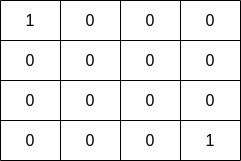2658 - Maximum Number of Fish in a Grid
You are given a 0-indexed 2D matrix grid of size m x n, where (r, c) represents:
- A land cell if
grid[r][c] = 0, or - A water cell containing
grid[r][c]fish, ifgrid[r][c] > 0.
A fisher can start at any water cell (r, c) and can do the following operations any number of times:
- Catch all the fish at cell
(r, c), or - Move to any adjacent water cell.
Return the maximum number of fish the fisher can catch if he chooses his starting cell optimally, or 0 if no water cell exists.
An adjacent cell of the cell (r, c), is one of the cells (r, c + 1), (r, c - 1), (r + 1, c) or (r - 1, c) if it exists.
Example 1:

Input: grid = [[0,2,1,0],[4,0,0,3],[1,0,0,4],[0,3,2,0]] Output: 7 Explanation: The fisher can start at cell(1,3)and collect 3 fish, then move to cell(2,3)and collect 4 fish.
Example 2:

Input: grid = [[1,0,0,0],[0,0,0,0],[0,0,0,0],[0,0,0,1]] Output: 1 Explanation: The fisher can start at cells (0,0) or (3,3) and collect a single fish.
Constraints:
m == grid.lengthn == grid[i].length1 <= m, n <= 100 <= grid[i][j] <= 10
Solution 1: DFS
JAVA
class Solution { private int[][] grid; private int m; private int n; public int findMaxFish(int[][] grid) { m = grid.length; n = grid[0].length; this.grid = grid; int ans = 0; for (int i = 0; i < m; ++i) { for (int j = 0; j < n; ++j) { if (grid[i][j] > 0) { ans = Math.max(ans, dfs(i, j)); } } } return ans; } private int dfs(int i, int j) { int cnt = grid[i][j]; grid[i][j] = 0; int[] dirs = {-1, 0, 1, 0, -1}; for (int k = 0; k < 4; ++k) { int x = i + dirs[k], y = j + dirs[k + 1]; if (x >= 0 && x < m && y >= 0 && y < n && grid[x][y] > 0) { cnt += dfs(x, y); } } return cnt; } }
C++
class Solution { public: int findMaxFish(vector<vector<int>>& grid) { int m = grid.size(), n = grid[0].size(); int ans = 0; function<int(int, int)> dfs = [&](int i, int j) -> int { int cnt = grid[i][j]; grid[i][j] = 0; int dirs[5] = {-1, 0, 1, 0, -1}; for (int k = 0; k < 4; ++k) { int x = i + dirs[k], y = j + dirs[k + 1]; if (x >= 0 && x < m && y >= 0 && y < n && grid[x][y]) { cnt += dfs(x, y); } } return cnt; }; for (int i = 0; i < m; ++i) { for (int j = 0; j < n; ++j) { if (grid[i][j]) { ans = max(ans, dfs(i, j)); } } } return ans; } };
PYTHON
class Solution: def findMaxFish(self, grid): self.m, self.n = len(grid), len(grid[0]) self.grid = grid ans = 0 for i in range(self.m): for j in range(self.n): if grid[i][j] > 0: ans = max(ans, self.dfs(i, j)) return ans def dfs(self, i, j): cnt = self.grid[i][j] self.grid[i][j] = 0 # Mark the cell as visited dirs = [(-1, 0), (1, 0), (0, -1), (0, 1)] for dx, dy in dirs: x, y = i + dx, j + dy if 0 <= x < self.m and 0 <= y < self.n and self.grid[x][y] > 0: cnt += self.dfs(x, y) return cnt
Comments
Post a Comment